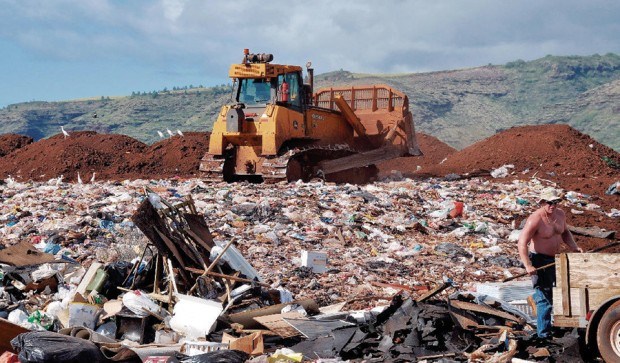LIHU‘E — Sometimes less is more. In this case, it’s about smaller chunks that can be compacted tighter and take less space, potentially buying more time for a landfill that keeps expanding. But it’s not going to happen, at least
LIHU‘E — Sometimes less is more. In this case, it’s about smaller chunks that can be compacted tighter and take less space, potentially buying more time for a landfill that keeps expanding. But it’s not going to happen, at least for now, as the Kaua‘i County Council shelved a proposal for a solid waste shredder.
Council members have been pressing the administration for years to step up recycling efforts on the island as the Kekaha Landfill nears capacity.
Permits to raise the landfill’s height and to add two cells added quite a few more years to the capacity of Kekaha’s 85-foot-high mountain of trash, and now the landfill is scheduled to close by 2020 — despite the lack of a new landfill site being officially secured.
On Wednesday, a private company proposed an additional method to extend the life of the landfill: shredding the county solid waste with a $1 million shredder and compacting it almost twice as much as is currently done.
Although being “interested” in the option presented by Shredco operations manager Danford Kaeo, the administration “is not convinced yet,” County Engineer Larry Dill said.
Kaeo presented the council a set of numbers and calculations, some of those disputed by Dill. Some council members also wanted to see more recycling efforts rather than spending more money on heavy equipment with a track history of failure and costly maintenance.
Kaeo said a shredder operates at a low speed and high torque, shredding the trash into small pieces. A magnet then picks up metals from the pile of shredded material, reducing the bulk of the trash by approximately 6.7 percent.
Kekaha Landfill Phase II, Cell I was designed to last 3.4 years. But 14 months after opening, Cell I is more than half-full and will reach capacity in 14 months, a year short of its target, according to Kaeo.
He said this is mainly due to the current compacting rate, 1,000 pounds per cubic yard, when the goal should be 1,400 pounds per cubic yard, which was the number calculated in the Environmental Assessment in December 2007.
The shredder would achieve 1,800 pounds per cubic yard, allowing the landfill to survive 45 percent to 60 percent longer, according to Kaeo.
Kaeo said the current compacting rates he had on hand were obtained by Waste Management, the private company that operates the landfill.
But Dill said those numbers are wrong, and the administration is on track.
The current compacting rates, Dill said, are 1,500 pounds per cubic yard. And those numbers were also obtained from Waste Management, he said.
Pros and cons
Solid Waste Coordinator Troy Tanigawa said the machine would definitely extend the life the landfill, and would also allow the administration to gather information which could be used in the design and operation of the new landfill, scheduled for 2020.
But the new machine had its cons too. Tanigawa said a shredder would increase overall operational costs for the county.
And as Kaeo said, the expensive piece of machinery needs daily maintenance to minimize expensive fixes which may take long periods.
Dill said the landfill receives trash on a daily basis, and if the shredder had to be set aside for maintenance, this could present a problem.
Adding to the potential cons, Tanigawa said the landfill staff would need to adjust operations to fully take advantage of the shredder, and there could be a an increase in fugitive debris from the landfill. The council heard all the issues and will be forwarding questions to appropriate agencies, especially regarding the discrepancy in current compacting rates presented by Kaeo and the administration.
Meanwhile, county officials said they have been working toward achieving a goal of diverting 70 percent of solid waste by 2023.
“We’re going to have to really work hard to get there,” said Allison Fraley, Solid Waste Program Coordinator.


